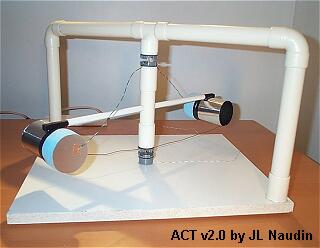

The Asymmetrical Capacitor Thruster v2.0
By Jean-Louis
Naudin
created on
November 18th, 2001 - JLN Labs
- Last update November 22th, 2001
All informations in this page are published free and
are intended for private/educational purposes and not for
commercial applications
This experiment is the continuation of the NASA Asymmetrical Capacitor Thruster ( ACT ) tests, that I have started on Nov 18, 2001 ( see the previous tests ). The first version was the closest setup and design to the original version tested by Transdimensionnal Technologies at the Marshall Space Flight Center.
Today, for going further, I have tried to increase the thrust by using a bigger and lighter Asymmetrical Capacitor Thruster....
ACT v1.0 : The first working design specification was :
Main armature
:
- Copper tube ( 30 mm diam, 1mm thick and 40mm length ).
Dielectric
:
- A Polystyrene "Roofmat"
cylinder block ( 32 mm diam and 33 mm length )
Secundary
armature :
- an aluminum disk 30 mm diam and 0.5 mm thick.
Weight : 40 g ( each )
ACT v2.0 : The new design specifications are :
Main armature
:
- Aluminum tube ( 65 mm diam, 1/10 mm thick and 80mm
length ).
Dielectric
:
- A Polystyrene "Roofmat"
cylinder block ( 67 mm diam and 35 mm length )
Secundary
armature :
- an aluminum disk 65 mm diam and 0.5 mm thick.
Weight : 26 g ( each )
The photo below shows the two versions of the ACT units :
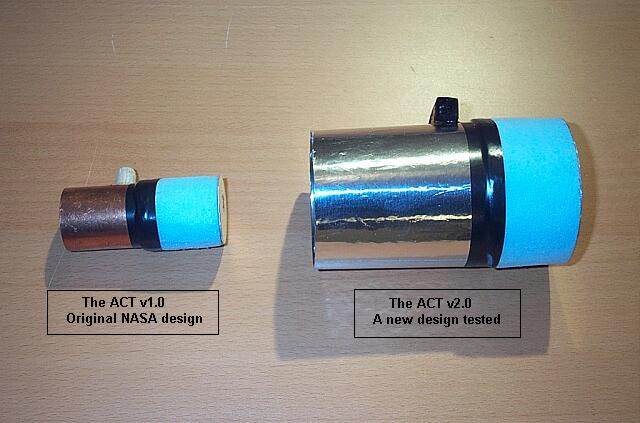
Experiment : I have used the same rotating apparatus and the same High Voltage generator for conducting this test.
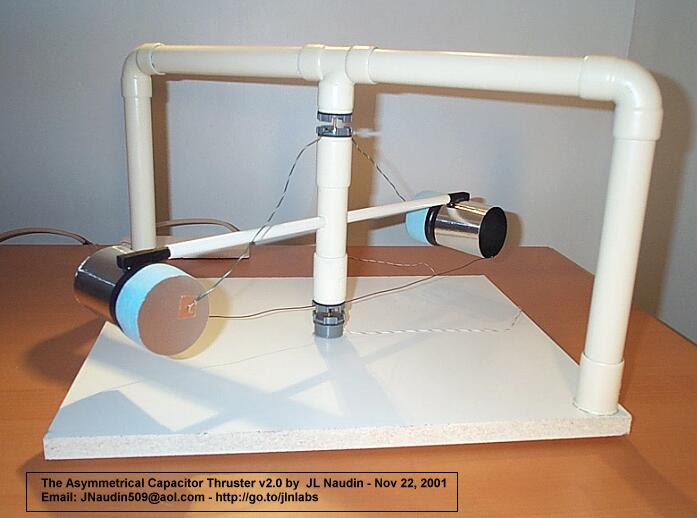

The two asymmetrical capacitors are
made with an aluminum tube, a Polystyrene
"Roofmat"
cylinder for the dielectric and an aluminum disk.
The capacitors are fixed on a 440 mm
diameter frictionless rotor, and the HV is sent through the main
rotation axis.
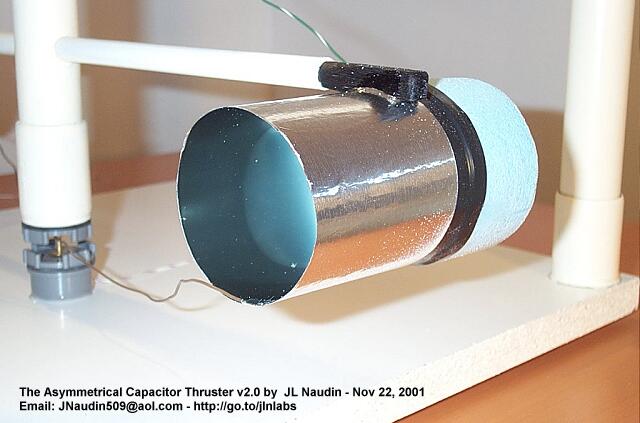
TESTS RESULTS ( 11-22-01 ) :
When the HV power supply is switched on, the ACT v2.0 doesn't want to rotate in spite of the High Voltage sent ( up to the spark ). I have noticed only a tiny motion ( about 10° ) during the power up.
WHY is the thrust so weak ?, there are some possible reasons which may explain this failure :
The NASA original setup has used a thick ( 1mm ) copper tube, in this new setup I have used a thin ( 1/10 mm ) aluminum tube
The NASA original setup was heavier ( 40 g ) than this new setup ( 26 g )
IMHO, I think that this weight of the new apparatus is responsible of this failure, there is less conductive material ( less conductive atoms ) subject to the Electrogravitics effect and thus, in spite of a bigger size of the capacitor, the thrust isn't sufficient to overcome the friction of the rotor.
May be also that the thickness of the tube, lower than in the original version, is responsible of this weak thrust.
The failure of the ACT v2.0 test is very interesting and gives me some valuable informations about the unknown working principles of the Asymmetrical Capacitor Thruster.....
See the video of ACT v2.0 tests
To see the videos, the free
downloadable RealPlayer is required ![]()
Click on the picture above to see the video ( 392 Kb )
See also :
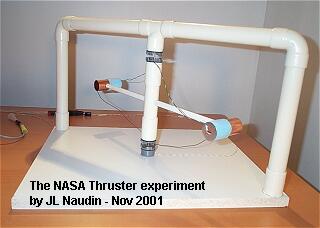 The
NASA Two Dimensional Asymmetrical Capacitor Thruster
The
NASA Two Dimensional Asymmetrical Capacitor Thruster
![]() Email : JNaudin509@aol.com
Email : JNaudin509@aol.com
Return to the Lifters experiments page